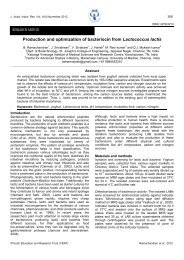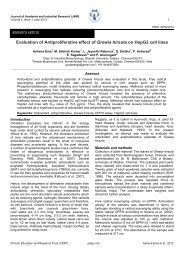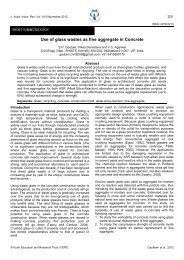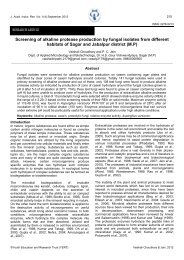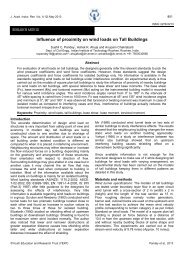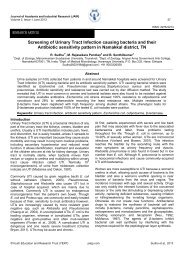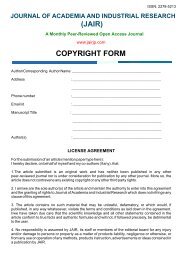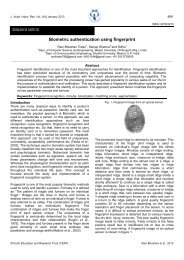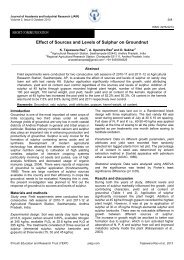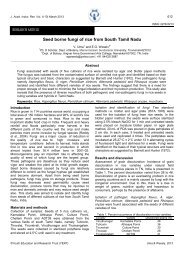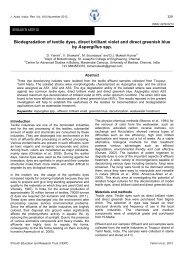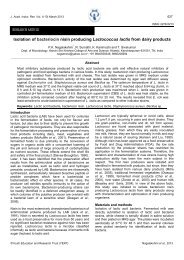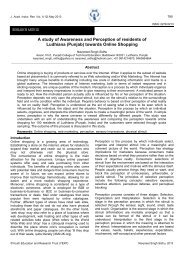Utilization of demolished waste as fine aggregate in Concrete
Utilization of demolished waste as fine aggregate in Concrete
Utilization of demolished waste as fine aggregate in Concrete
Create successful ePaper yourself
Turn your PDF publications into a flip-book with our unique Google optimized e-Paper software.
J. Acad. Indus. Res. Vol. 1(7) December 2012 399Table 1. Physical properties <strong>of</strong> recycled <strong>aggregate</strong>.PropertiesObserved valuesColourP<strong>in</strong>kish brownSpecific gravity 2.5Water absorption (%) 3.03-4.5Table 2. Properties <strong>of</strong> cement.PropertiesRequirementObserved<strong>as</strong> pervaluesIS:8112-1989Normal consistency - 28%Initial sett<strong>in</strong>g time 30 m<strong>in</strong> 113 m<strong>in</strong>F<strong>in</strong>al sett<strong>in</strong>g time 600 m<strong>in</strong> 317 m<strong>in</strong>3 d compressive strength 23 N/mm 2 23.67 N/mm 27 d compressive strength 33 N/mm 2 34.67 N/mm 228 d compressive strength 43 N/mm 2 44.33 N/mmSoundness test Up to 10 mm 2.5 mmF<strong>in</strong>eness test (90 µ sieve) Up to 10% 0.98%ISsievesizeTable 3. Sieve analysis (F<strong>in</strong>e <strong>aggregate</strong>).Weight Cumulativereta<strong>in</strong>ed weight(g) reta<strong>in</strong>ed (g)% cumulativeweight reta<strong>in</strong>ed10 mm 0 0 0.004.75 mm 110 110 11.002.36 mm 52 162 16.201.18 mm 175 337 33.70600 µ 128 465 46.50300 µ 250 715 71.50150 µ 240 955 95.50ISsievesizeTable 4. Properties <strong>of</strong> <strong>f<strong>in</strong>e</strong> <strong>aggregate</strong>.PropertiesObserved valuesF<strong>in</strong>eness modulus 2.74Specific gravity 2.63Table 5. Sieve analysis (Coarse <strong>aggregate</strong>).WeightCumulativereta<strong>in</strong>edweight reta<strong>in</strong>ed (g)(g)% Cumulativeweightreta<strong>in</strong>ed16 mm 0 0 0.0012.5 mm 124 124 2.4810 mm 1186 1310 26.204.75 mm 3520 4830 96.602.36 mm 115 4945 98.901.18 mm 55 5000 100.00600 µ - 5000 100.00300 µ - 5000 100.00150 µ - 5000 100.00Table 6. Properties <strong>of</strong> <strong>aggregate</strong>.PropertiesObserved valuesF<strong>in</strong>eness modulus 6.22Specific gravity 2.64F<strong>in</strong>e <strong>aggregate</strong>: The <strong>f<strong>in</strong>e</strong> <strong>aggregate</strong> is locally availableriver sand, which is p<strong>as</strong>sed through 4.75 mm sieve.Result <strong>of</strong> sieve analysis <strong>of</strong> <strong>f<strong>in</strong>e</strong> <strong>aggregate</strong> and physicalproperties are given <strong>in</strong> Table 3 and 4 respectively.Coarse <strong>aggregate</strong>: The coarse <strong>aggregate</strong> locallyavailable crushed stone <strong>aggregate</strong>, 12 mm maximum <strong>of</strong>s<strong>in</strong>gle lot size h<strong>as</strong> been used trough out the experimentthe specific gravity <strong>of</strong> coarse <strong>aggregate</strong> w<strong>as</strong> 2.7. Thegrad<strong>in</strong>g <strong>of</strong> coarse <strong>aggregate</strong> are given <strong>in</strong> the Table 5 and6.Water: Potable water is used for mix<strong>in</strong>g and cur<strong>in</strong>g. Onaddition <strong>of</strong> higher percentage <strong>of</strong> <strong>demolished</strong> <strong>w<strong>as</strong>te</strong> therequirement <strong>of</strong> water <strong>in</strong>cre<strong>as</strong>es for the same workability.Thus a constant slump h<strong>as</strong> been the criteria fir waterrequirement but the specimens hav<strong>in</strong>g 0% <strong>demolished</strong><strong>w<strong>as</strong>te</strong>, w/c <strong>of</strong> 0.50 h<strong>as</strong> been used.<strong>Concrete</strong>: The concrete mix design is done <strong>in</strong>accordance with IS: 10262 (1982). The cement content<strong>in</strong> the mix design is taken <strong>as</strong> 380 kg/cu. m 3 whichsatisfies m<strong>in</strong>imum requirement <strong>of</strong> 300 kg/cu. m <strong>in</strong> orderto avoid the ball<strong>in</strong>g effect. Good stone <strong>aggregate</strong> andnatural river sand <strong>of</strong> zone-II w<strong>as</strong> used <strong>as</strong> coarse<strong>aggregate</strong> and <strong>f<strong>in</strong>e</strong> <strong>aggregate</strong> respectively. Maximumsize <strong>of</strong> coarse <strong>aggregate</strong> w<strong>as</strong> 12.5 mm. a sieve analysisconform<strong>in</strong>g to IS: 383-1970 w<strong>as</strong> carried out for both the<strong>f<strong>in</strong>e</strong> and coarse <strong>aggregate</strong>. This study is a part <strong>of</strong>comprehensive programme where<strong>in</strong> experimental<strong>in</strong>vestigations have been carried out to <strong>as</strong>sess the effect<strong>of</strong> replacement <strong>of</strong> regular material by a cheaper substitutei.e. <strong>demolished</strong> <strong>w<strong>as</strong>te</strong> on strength <strong>of</strong> concrete. For thisstudy cubes <strong>of</strong> 100 mm size were c<strong>as</strong>t by replac<strong>in</strong>g <strong>f<strong>in</strong>e</strong><strong>aggregate</strong> by <strong>demolished</strong> <strong>w<strong>as</strong>te</strong>. Compressive strength <strong>of</strong>this recycled concrete were observed and compared withthose <strong>of</strong> natural <strong>aggregate</strong> concrete. To achieve thiscomparative study, cubes were c<strong>as</strong>t replac<strong>in</strong>g <strong>f<strong>in</strong>e</strong><strong>aggregate</strong>s by 10%, 20%, and 30% with <strong>demolished</strong><strong>w<strong>as</strong>te</strong> for a comparative study with respect toconventional concrete. These specimens were testedafter 7 and 28 d. To identify cube strength, a mixproportion <strong>of</strong> 1:1.67:3.33 w<strong>as</strong> used dur<strong>in</strong>g the<strong>in</strong>vestigation.Results and discussionThe observations made dur<strong>in</strong>g the test <strong>of</strong> cubes aresummarized <strong>as</strong> workability and compressive strength arepresented <strong>in</strong> tabular form (Table 7). Three specimens eachhav<strong>in</strong>g 0%, 10%, 20%, and 30% <strong>demolished</strong> <strong>w<strong>as</strong>te</strong> <strong>as</strong> <strong>f<strong>in</strong>e</strong><strong>aggregate</strong> replacement for mix <strong>of</strong> 1:1.67:3.33 were c<strong>as</strong>tand tested after 7 days and 28 d <strong>in</strong> order to have acomparative study.Workability: Workability is the relative e<strong>as</strong>e with whichconcrete can be mixed, placed, compacted and f<strong>in</strong>ished.While c<strong>as</strong>t<strong>in</strong>g specimens, slump test were carried out todeterm<strong>in</strong>e the workability <strong>of</strong> different samples <strong>as</strong> perIS: 6461-1973 (Fig. 1).©Youth Education and Research Trust (YERT) Mohd Monish et al., 2012



